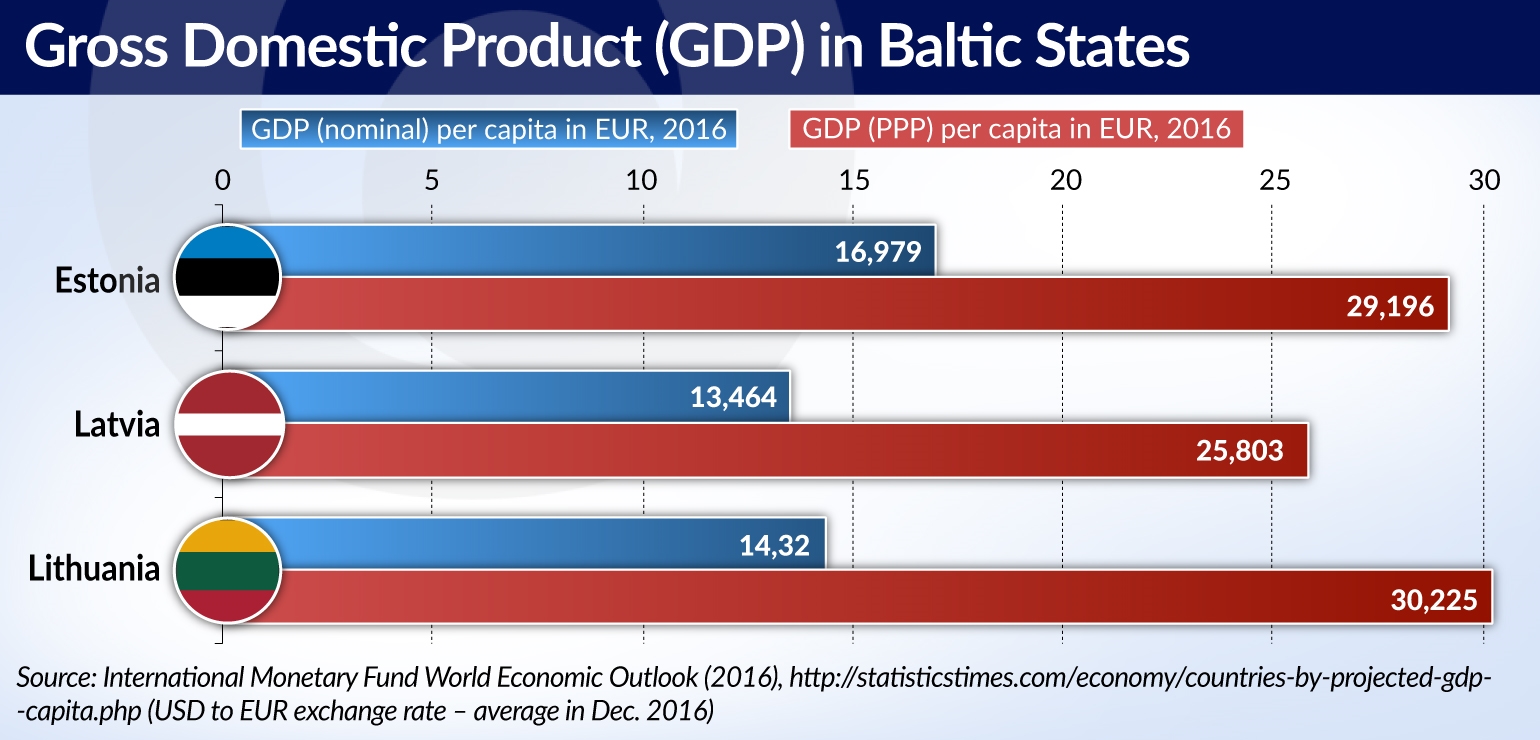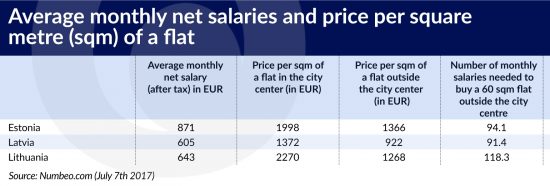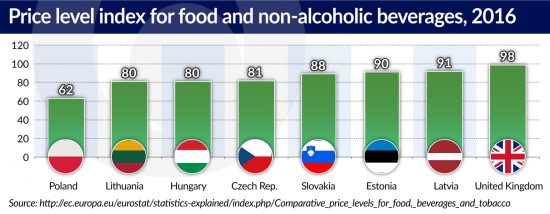By Michał Kowalczyk.
Baltics – More than 25 years have passed since the collapse of the Soviet Union. Lithuania, Latvia, and Estonia have an indisputable reputation of being the most developed of former republics of USSR.
These states have often been called “Baltic States” or “Baltic Tigers” – due to their economic reforms, foreign investments, and fast growth of GDP, especially between 2004 and 2007. In spite of crisis in 2008-2009, resulting in deep recession, the past quarter of a century can certainly be considered successful for Lithuania, Latvia, and Estonia. But is the success complete in comparison to other states of Central and Southeast Europe (CSE)?
“Baltic Tiger” is a term used to refer to Estonia in particular, as the richest and best developed country among the three Baltic States. According to data of the International Monetary Fund from 2016, Estonia has the highest Gross Domestic Product per capita (nominal) among them. GDP per capita in Lithuania is visibly lower than in Estonia, however PPP per capita is surprisingly higher. Both indicators are the lowest in Latvia.
Since the Baltic States have become members of European Union in 2004, three different periods can be distinguished in the developments of their economies:
- Until 2007 the growth was stable and fast, Latvia achieving the highest growth of 11.9 per cent growth in 2006;
- Between 2008-2009 the Baltic Tigers faced an economic crisis and deep recession – in 2009 all three states experienced a recession of more than 14 per cent;
- After 2010 these countries, especially Estonia, have experienced a stable but relatively sluggish growth thanks to the implementation of harsh austerity policies during the crisis. Nowadays, the Baltic States have stable economies with low public deficit and debt levels.
Human Development Index (HDI) in Baltic States
According to the Human Development Index (HDI), all three Baltic States are ranked as very highly developed. With index 0.865, Estonia is ranked the 30th, along with Brunei Darussalam. Among post-communist states, or countries being part of communist states in the past, only Slovenia and the Czech Republic are ranked higher, 25th and 28th respectively. Lithuania is ranked the 37th, with index 0.848, just after Poland (0.855), Qatar, Malta, and Cyprus (0.856 for all of three). Meanwhile Latvia is ranked the 44th (0.830), just after Hungary (0.836), but before Argentina and Croatia (both have 0.827).
Baltic States are ranked ahead of other states formerly being part of the Soviet Union. For instance, the Russian Federation is ranked the 49th (0.804), Belarus the 52nd (0.796), Kazakhstan the 56th (0.794), Ukraine the 84th (0.743), whereas Moldova is the 107th (0.699). Human Development Index is based on life expectancy and economic indicators, and represents the human progress. Thanks to HDI, we can conclude that there are enormous differences between former republics of the Soviet Union in the living standard, economy, and human progress. Without doubt, in these areas the Baltic States can be considered really successful compared to such states as Ukraine or Moldova.
Unemployment Rate
According to Eurostat, the average unemployment rate in the European Union in 2017 is estimated to be 7.8 per cent (however among EA19 states, belonging to Eurozone, it is 9.3 per cent). Estonia has the lowest unemployment rate among the Baltic States (6.2 per cent), whereas it is 7.3 per cent in Lithuania and 8.3 per cent in Latvia. As far as unemployment is concerned, these countries do not stand out from other EU members. What is more, amidst post-communist countries, lower unemployment rates are in the Czech Republic (3.0 per cent – the lowest in EU), Hungary (4.3 per cent), Poland (4.8 per cent), Romania (5.4 per cent), and Bulgaria (6.0 per cent). Among the post-communist states only Croatia has a higher unemployment rate than Latvia (10.7 per cent). The highest unemployment rates in EU are in Greece (22.5 per cent) and Spain (17.7 per cent).
Such results of Baltic States do not seem to be very impressive. Furthermore, it is noteworthy to emphasize that the populations of Estonia, Lithuania, and Latvia have visibly declined since 1990, and many members of the younger generation have emigrated to the West and to Scandinavia. Population of Lithuania in 1990 was estimated at 3.7 million, of Latvia at 2.66 million, while that of Estonia was about 1.57 million, whereas in 2015, the population of Lithuania was estimated only at 2.91 million, of Latvia at 1.98 million, and of Estonia at 1.31 million. Being conscious of such declines in population, we should underscore that mass emigration evidently helped to reduce unemployment rates, especially in case of Lithuania, where almost ¼ of the population left the country.
Salaries and expenses
Undoubtedly, the highest salaries among the Baltic States are those in Estonia. The average monthly net salary (after tax) in Estonia is estimated at EUR871. It is more than in Czech Republic (EUR849), Portugal (EUR814), Slovakia (EUR777), or Poland (EUR763). However, it is less than in Slovenia (EUR1012), so among countries of CSE Estonia is the second country with the highest salaries. In Lithuania it is EUR643, whereas in Latvia it is EUR605. Amidst EU members only three countries have lower salaries: Romania (EUR561), Hungary (EUR507), and Bulgaria (EUR465).
Prices of apartments seem very high in Lithuania, higher than in Estonia and much higher than in Latvia. In the CSE only the Czech Republic has a higher average price for square meter (sqm) of a flat in the city center (EUR2,327) than Lithuania, and the prices are even lower in Slovenia (EUR1,859) or in Poland (EUR1,772). However, among the Baltic States, Estonia has the highest average price of one square meter of flat outside of the city center.
Although the Average Monthly Net Salary in Latvia is the lowest among Baltic States, its citizens theoretically need to work the shortest time to buy a 60 sqm flat outside the city center: it would cost 91.4 average monthly salaries. This is obviously determined by relatively low prices of flats in Latvia. In Estonia, such a flat would cost 94.1 average monthly salaries; meanwhile in Lithuania it would be 118.3 average monthly salaries, which perfectly shows how exorbitant the prices in the country are, and does not encourage the young generation to stay in their homeland.
Food and beverages
Prices of food and beverages in the Baltic States are relatively high when compared to average salaries, especially in Latvia. According to Eurostat, among EU members the prices of food and non-alcoholic beverages were the lowest in Poland and Romania, with price level index of 62. In Lithuania it was 80 (read why Lithuanians prefer to shop in Poland), whereas in Estonia and in Latvia 91. At the same time, the price level index in the United Kingdom was 98, therefore there is a lower difference in prices of food and non-alcoholic beverages between Latvia and the United Kingdom than between Latvia and Poland, despite the fact, that salaries in Poland are definitely higher than in Latvia. Thus it is quite difficult to save money for a flat in Latvia, even if the price of one sqm of a flat is very low compared to other states of EU, including the countries of Central and Eastern Europe.
Undoubtedly, the governments of Lithuania, Latvia, and Estonia are facing significant challenges if they are to regain the name of Baltic Tigers. Although the economic growth is stable, it is relatively sluggish and in need of impulses to increase its pace. First of all, it would be necessary to persuade the citizens to stay in their countries, which cannot be an easy task with prices of properties and costs of life that high. Currently, it is hard to call the Baltic States Baltic Tigers anymore.
Article originally published on the Financial Observer.







